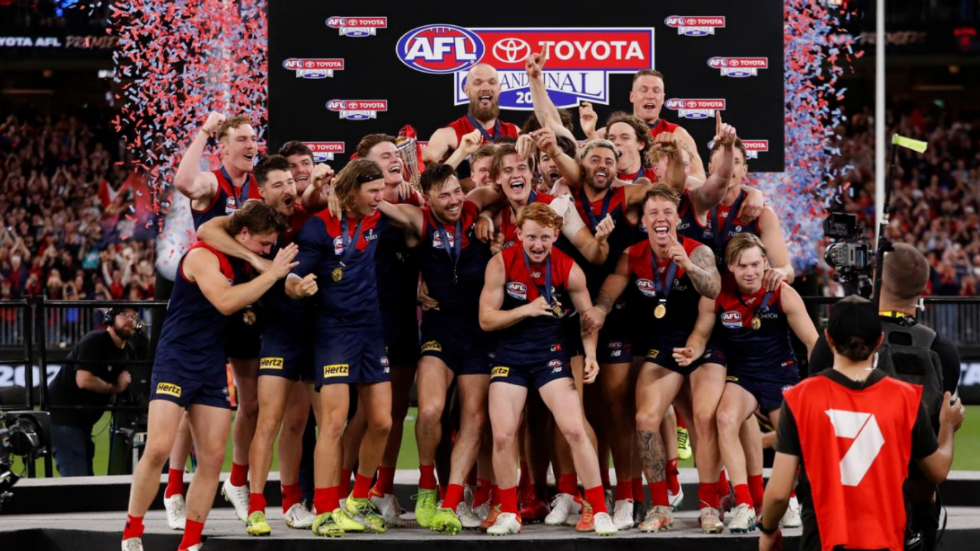Thanks to the AFL’s equalisation policies, many teams like Melbourne have been able to break long premiership droughts. Photo: GETTY IMAGES
Even when all our cars are electric, and the last of those with the fading “Up Yours Oakley” bumper stickers are consigned to the wreckers’ yards, Bulldog supporters will view the AFL Commission with suspicion.
Likewise, those Melbourne fans with long memories of the bitter divisions the Commission’s attempted merger inflicted on the club.
Yet along with the Swans, the AFL’s lovechild-pioneer for the rugby states, Melbourne and the Bulldogs have arguably gained most from the Commission model of league administration.
The salary cap, equalisation funding and the draft have helped make real the kind of tight competition league administrators had craved since the 1960s.
In the words of VFL spokesman Terry Young in 1968: “In the presentation of any competition the ultimate aim of the promoter must be to have all clubs as evenly matched as possible so that interest will remain in the competition right throughout the season.”
Young was explaining the reasoning behind one of the biggest changes the VFL had introduced: the introduction of country zoning with each of 12 regions in rural Victoria assigned to a particular club.
The problem was that the recognised power clubs of the 1950s and ‘60s dominated recruiting of country players so much that the league decided the competition was lopsided, predictable and would remain so unless the battlers had a fairer share of the talent pool.
Again, in Terry Young’s words: “In recent years the last six or eight rounds of the season has produced only two or three matches each week sufficiently attractive to draw reasonable crowds … the league in attempting to overcome this problem decided on a division of the whole of the state and the Riverina into 12 sections.”
So how did that work out? It was mostly a failure. Some battling clubs benefited: Hawthorn enjoyed a golden era ushered in by its rich Mornington Peninsula-West Gippsland zone; North Melbourne picked up its first premiership and Team of the Century selection Sam Kekovich among others; and Footscray became newly competitive, but overall, fewer clubs than before could realistically hope to win, or even reach, a grand final.
PLEASE HELP US CONTINUE TO THRIVE BY BECOMING AN OFFICIAL FOOTYOLOGY PATRON. JUST CLICK THIS LINK.
From 1944 to 1967, 10 of the 12 clubs had won a premiership and all 12 had taken the field in a grand final. Yet from 1968 to 1989, with the league’s model for a more even competition in place, only five clubs won a flag, and only seven of 12 reached a grand final.
Compare those results to how the AFL has functioned this century. A clear majority of the 18 clubs – 11 – have won a premiership since 2000, and 15 have reached a grand final. Push back another two years to 1998 and 13 clubs have won a flag and 17 – all but Gold Coast – have played off for the title.
Along the way, this century has seen a flood of drought-busting premierships: the Swans after 72 years; the Bulldogs after 62 years; Melbourne after 57 years; the Fitzroy-Brisbane Lions also after 57 years; and Geelong after 44 years.
And right now, as finals season approaches, the ladder is a shifting stew of permutations with only top position settled, the rest of the top eight subject to change with six clubs eyeing a double chance.
There is plenty that fans of all stripes might find troubling about what happens under the AFL Commission’s watch: the constant invention of new rules and the shifting “interpretations” of existing ones; the inconsistencies of the tribunal and its unpredictable appeals system; the unequal fixture; and a seeming disregard for tradition that makes for an annual arm wrestle about what time of day the grand final might be played.
But about the competition’s sharing of the spoils, there is less cause for complaint.
Country zoning is an example of what happens when the clubs are allowed to run the show, because the old VFL was essentially the clubs working to their own self-interest.
The Commission model is what happens when sport administrators really want an evenly-matched competition. For that, even the Bulldogs’ and Demons’ fans can give thanks.
Ian Munro is the author of ‘Between The Flags – Making Sense of 57 Years of Heartache’, about the Demons’ wilderness years and their return to glory in 2021. You can purchase the book at WWW.BETWEENTHEFLAGS57.COM.AU











